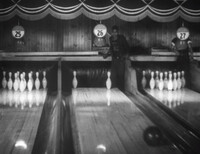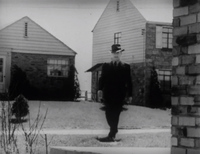The Segregated Workplace
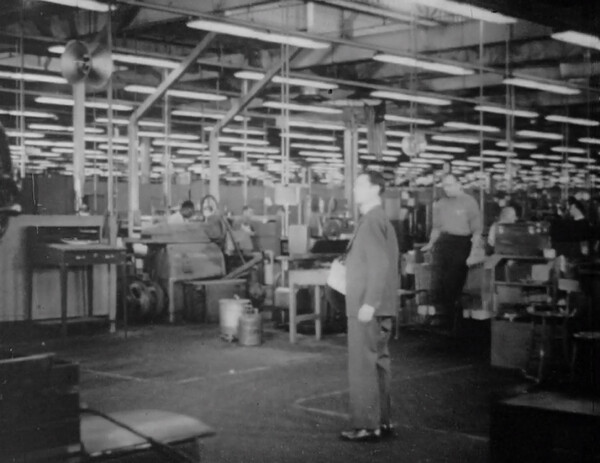
Segregation made its way into the Problems in Supervision series, with only sparse inclusion of any minorities on screen. This wide shot from Introducing the New Worker to His Job, with an African American man working in the distant background was a rare exception.
In the first few decades of the twentieth century, the working lives of African Americans in America took different shapes than their white counterparts. Often poor and without advanced skills in the labor force, many minorities gravitated towards manual labor and frequently agricultural positions. Groups such as first generation Japanese Americans out West and African Americans in the South saw large concentrations in agricultural positions.80 Due to continuing industrialization within cities, especially in the North, minorities increasingly moved towards these urban areas in search of higher pay and better living conditions. For African Americans, the move from the rural life in the South to urban industrial centers in the North was termed the Great Migration, and would continue well after World War II.81 The majority of African American farmers in the South were sharecroppers, individuals who leased farm land from others, often white farmers, in exchange for direct money or a percentage of produce. The introduction and adoption of mechanized farm equipment, often expensive for small farmers and sharecroppers, would make it harder to compete with large, well-equipped farming operations, and drive many African American farmers to leave the South.82 In addition to seeking greater economic opportunities, African Americans fled the South due to legalized segregation in the form of Jim Crow laws.83 While other parts of the United States may not have been as explicit, racial inequality and discrimination against African Americans and other minorities would be an unfortunate aspect of life. Whether in rural agriculture or in industrial pursuits, the economic trends of the early 1900s would stumble with the bleak realities of the 1930s.

Supervisors, like this depiction from A New Supervisor Takes a Look At His Job, often had to have deep knowledge of machines under their care. Something that likely only years of experience at a factory could provide.
Although impacting the entire U.S. population, the Great Depression would be particularly hard on African Americans. It is challenging to provide a perfect picture of the situation through economic data as the standard scientific collection and analysis of U.S. economic data was just beginning, but the limited sources do show some major trends and stark differences within the country. In 1930, within a year of the economic slide, significant discrepancies appeared in labor force studies estimating the percentage of the population needing assistance for survival; for whites 17 percent required support to survive compared to 38 percent of African Americans.84 Minorities, African Americans in particular, were especially hit hard in urban areas and northern cities.85 The 1930 census revealed that unemployment rates for African Americans in the North landed at 14.3 percent compared to 8.0 percent for whites.86 Cities were particularly hard hit due to drawbacks in jobs within highly urbanized industrial sectors as labor specialist Linda Levine explains, “In 1937, 29% of all jobless persons formerly worked for manufacturers, with nearly one-fourth having been employed by iron and steel producers. Another 12% had worked in textile industries and 10% in clothing industries.”87 The causes for such racial inequalities in employment were numerous, ranging from African Americans making up a larger proportion of unskilled labor and thus easier to cut and replace, the lower time on the job as any African Americans were recent arrivals to the North and to specific employers, and in all likelihood racial biases.88 To survive, many African Americans turned to insulated economies, renting out their homes to newcomers or setting up low cost self-employment opportunities aimed at the African American community. These included restaurants, barber shops, and cosmetology endeavors.89 Unsurprising, facing high rates of unemployment, the migration of African Americans northward slowed, yet the Great Migration continued.90
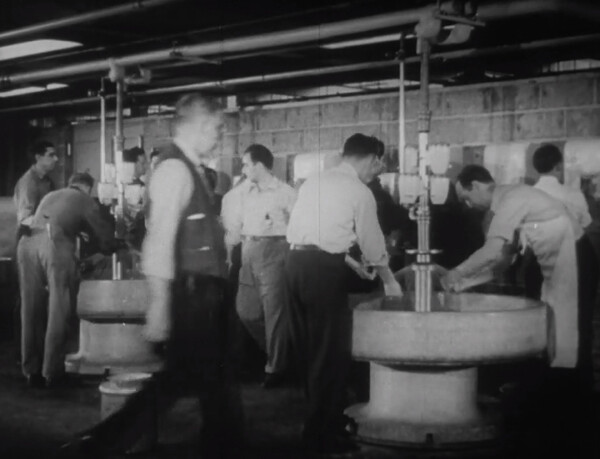
Large shots of supposedly casual settings taken for background images with narration minorities highlight the segregationist filming decisions in the series.
The Great Depression would not just hit urban workers either, minority farmers unequally felt the effects of the economic upheaval. Unlike industrial and urban labor, which was highly dependent on the health of large companies and others for continued employment, farmers were independent and could continue working even with economic uncertainty as otherwise their operations would be closed. Due to this difference, unemployment rates for farmers, especially concentrated in the South, were far less than their urban counterparts. For instance, the unemployment rate for farm owners and tenants in one 1937 estimate placed it as 2.5 percent, with a 10.8 percent unemployment rate for farm laborers; meanwhile, most other categories of workers were much higher, notably non-farm laborers at 19.9 percent and semiskilled laborers at 25.3 percent.91 Although staying in operation, farmers suffered from low margins, sagging crop prices, and fierce competition. Inequality was also highly apparent, with lower rates of pay for African American sharecroppers across the South.92 As for ownership, scholars debate the ownership rates of African American farms in the South by the end of the decade, due to the flight of African American sharecroppers.93 Regardless, it is clear that African American agricultural workers had a tough time during the interwar period.
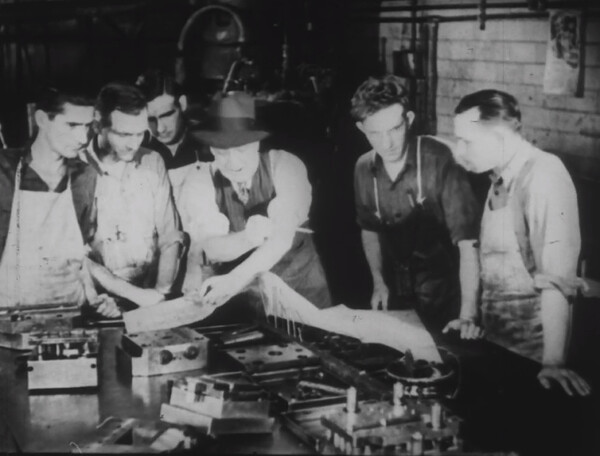
Depictions of work within the Problems in Supervision series rarely included minorities, like this shot of a supervisor with a group of workers.
Akin to other minority groups, World War II would bring economic opportunities to African Americans. The desperate need to fill factory positions would be answered by many African Americans, who started to stream from the rural South northwards into urban areas at higher rates than in the Great Depression.94 The movement to the urban North was for good reason, as African American incomes rose significantly due partially to new opportunities to advance into semi-skilled and skilled positions.95 Finding success in the North would become an ideal for African Americans everywhere, even those overseas. African Americans serving in the military had visions of the North after service, with 14 percent more expressing the desire to live outside of the South after the war than before the war, compared to only one percent of whites within the same survey.96
While playing an important role in the wartime economy, African Americans would not do so in the Problems in Supervision series. African Americans and most other minorities are virtually left out of all the films in the Problems in Supervision series. Even in films pertaining to introducing new workers into the workplace, wherein African Americans migrating northwards for industrial positions would clearly fit, did not have African Americans visible or highly visible on screen.97 It’s likely the lack of African American actors, or any minority actors for that matter, came about due to segregation practices. While not confirmed, exclusion of minorities from government-backed educational films was a common practice of the period. For instance, the United States Department of Agriculture, a major early film producer within the federal government, largely excluded African Americans in their motion pictures during the 1920s through early 1940s.98 Whether a direct slight against African Americans, an appeasement of segregationists, or the realities of creating films in the era, African Americans and other minorities were generally not included in the films.
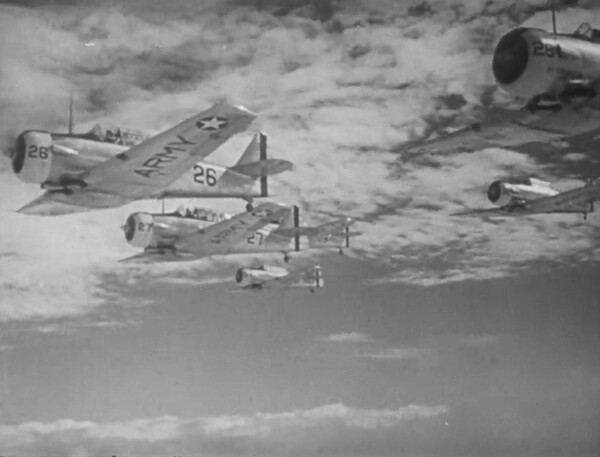
Although serving bravely in World War II, many African Americans and other minorities were left out of post-war benefit programs.
The post-war era would see mixed results for African Americans. Given the need for semi-skilled labor and the large number of casualties from the war, rates of African American semi-skilled labor continued to rise during the postwar years.99 This was not a phenomenon confined to the North either, rates of semi-skilled African American labor rose in the South from 15 percent in 1940 all the way to 45 percent by 1970.100 The Great Migration northwards would continue though until the 1970s as the pursuit of labor gains stayed as a guiding signal along with increasingly difficult survival of minority farmers with the growing mechanization of the agricultural industry.101 In other parts of the labor force, including for Africna American female labor, there was greater fear of a reversal to previous employment prospects after the war.102 Although serving faithfully in the war, African Americans were systematically restricted from participating in post-war benefits to soldiers.103 Referred to as the G.I. Bill, this legislation would aid mostly white soldiers in pursuing higher education and home ownership. The rise of suburban living and Veterans Administration secured loans allowed for many white families to leave urban areas while isolating African Americans and other minorities, creating challenges still felt today.

